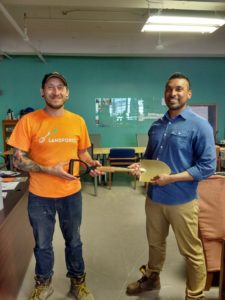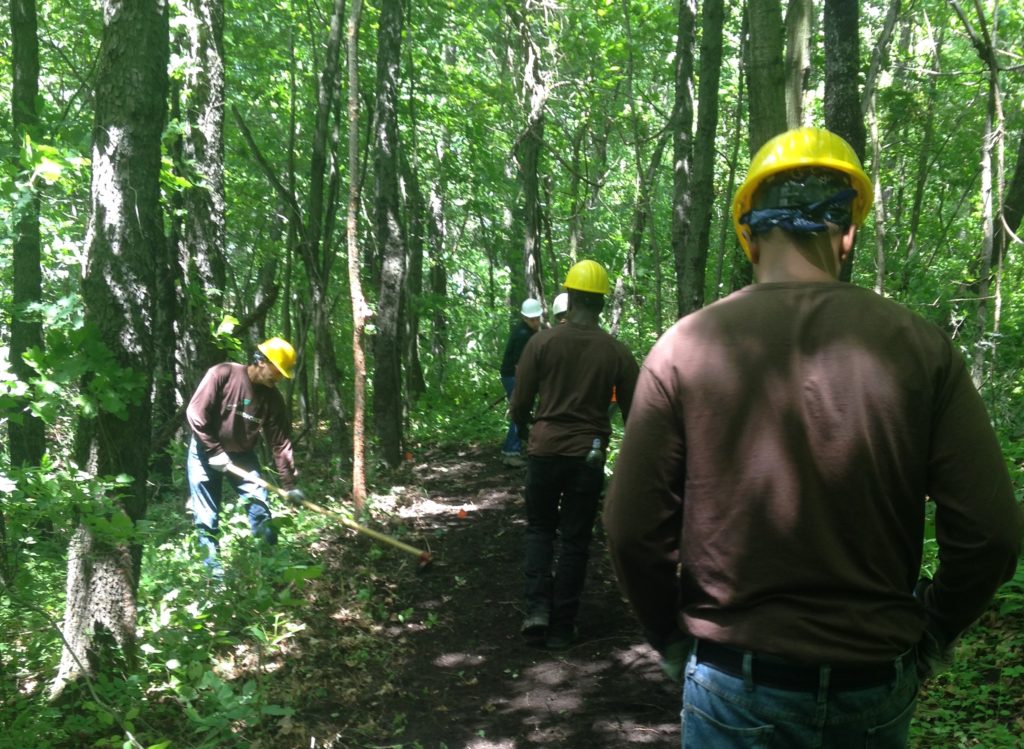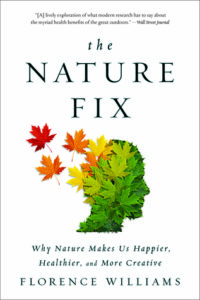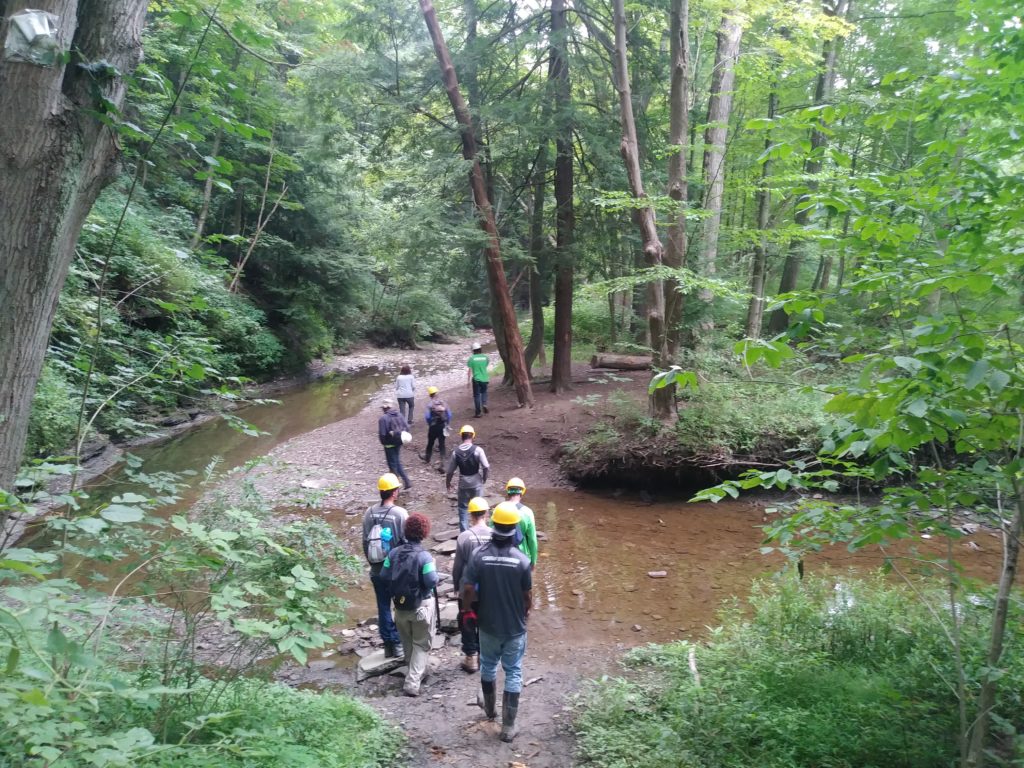
The Health Benefits of Working in Urban Green Spaces

This guest blog post was written by Arvin Simon, Ph.D. As a PhD student in Clinical Psychology at Duquesne University, Arvin studied the Emerald Trail Corps, the program that led to the creation of Landforce. When Arvin presented his findings to the Landforce Board and Staff in early May, Thomas presented him with our Golden Shovel Award for his perseverance and his thoughtful dissertation — an honor that, we’re certain, comes only a whisker’s breadth behind successfully completing his Ph.D. You can read some of what he learned on his journey below. Congratulations Dr. Arvin Simon!
For the past three years, I have been completing my doctoral dissertation which explores the personal and social benefits of working in urban parks. My research was mostly conducted in Mount Washington’s Emerald View Park, where I worked with a crew called the Emerald Trail Corps. This ETC program would eventually become Landforce. Before I go into my own research, let’s look at what the existing research says about being in urban green spaces.

Urban green spaces can be broadly defined to include parks, open habitats and lands (i.e. for agriculture, livestock, pollination etc.) within city or metropolitan areas. These spaces maintain vital social and ecological functions for cities. In addition to providing carbon and heat sinks, ground water capture and corridors for wildlife, there is evidence that these nature spaces promote health recovery and overall physical and mental well-being. Further research supports the effectiveness of urban green spaces in reducing rates of stress-related illness and diseases.

In her critically-acclaimed book titled, The Nature Fix, Florence Williams concluded that nature not only makes us healthier but also happier and more creative. For example, she cited an innovative study by scientists who developed a smartphone app that asked users to rate their emotional experiences at random times of the day. The app tracked user-reported data on their moods with their precise physical environment, using automated feedback from their mobile devices. From a dataset of over 20,000 participants and more than one million responses, they found—all things being equal— that participants were significantly happier being outdoors in green or natural habitats than they were inside buildings.
Now, what about the benefits of working in nature? From my own review of several different jobs programs that provided training and employment in either habitat restoration, urban gardening, or landscaping I found the following four themes were reported as major benefits of working in nature:
- Knowledge/Skills: People hired to work in nature developed not only specialist skills (e.g. planting trees, landscaping) but also social skills required to interact with the public.
- Self-improvement: Working in nature can help instill a sense of pride, self-confidence, positive attitude, maturity and self-control.
- Care for the environment: Workers also seemed to develop increased value and concern for the environment. Conversely, a sense of loss or distress was a common experience when the environment was intentionally damaged or polluted.
- Care for others: Another benefit included developing increased value and concern for others including family members, coworkers and the community-at-large.

In my own dissertation research with the crew working in Emerald View Park, I also found the following benefits:
- Nature was experienced as deeply therapeutic, both in childhood and later in life. When participants thought about their best experiences of nature, they thought of their childhood. Working in the woods was a way for most of them to reconnect to those experiences.
- What the crew members called “vision” was an artisanal skill (think of a sculptor visualizing the final form of the block of marble) developed and passed on from senior crew members to newer ones. Creating trails is a highly interpretive and creative process; developing this ability resulted in feelings of accomplishment and increased confidence.
- Leadership, vision and respect were basic factors underlying team work.
- Community experiences were strongly valued. The community’s ability to enjoy their urban park spaces strongly contributed to worker satisfaction.
If you are interested in exploring these topics further, check out the additional resources below!
- Roe, J. (2016). Cities, green space, and mental well-being. In H. Shugart (Ed.), Oxford research encyclopedia of environmental science (pp. 1-29). Oxford, UK: Oxford Press.
- Rose, J. F. P. (2016). The well-tempered city: What modern science, ancient civilizations, and human nature teach us about the future of urban life. New York, NY: HarperCollins.
- Davoudi, S., & Brooks, E. (2016). Urban greenspace and environmental justice claims. In S. Davoudi & D. Bell (Eds.), Justice and fairness in the city: A multidisciplinary approach to ‘ordinary’ cities (pp. 25-48). Chicago, IL: Policy Press.
- Heynen, N., Perkins, H. A., & Roy, P. (2006). The political ecology of uneven urban green space the impact of political economy on race and ethnicity in producing environmental inequality in Milwaukee. Urban Affairs Review, 42(1), 3-25.
- Velarde, M. D., Fry, G., & Tveit, M. (2007). Health effects of viewing landscapes – Landscape types in environmental psychology. Urban Forestry & Urban Greening, 6(4), 199-212.
- Brooke, I. (2010). The importance of nature, green spaces, and gardens in human well-being. Ethics, Place and Environment, 13(3), 295-312.
- Fuller, R. A., Irvine, K. N., Devine-Wright, P., Warren, P. H., & Gaston, K. J. (2007). Psychological benefits of greenspace increase with biodiversity. Biology Letters, 3(4), 390-394.
- Maas, J., Van Dillen, S. M., Verheij, R. A., & Groenewegen, P. P. (2009). Social contacts as a possible mechanism behind the relation between green space and health. Health & Place, 15(2), 586-595.
- Gidlöf-Gunnarsson, A., & Öhrström, E. (2007). Noise and well-being in urban residential environments: The potential role of perceived availability to nearby green areas. Landscape & Urban Planning, 83(2), 115-126.
- Maller, C., Townsend, M., Pryor, A., Brown, P., & St. Leger, L. (2006). Healthy nature healthy people:‘contact with nature’as an upstream health promotion intervention for populations. Health Promotion International, 21(1), 45-54.
- Van den Berg, A. E., Maas, J., Verheij, R. A., & Groenewegen, P. P. (2010). Green space as a buffer between stressful life events and health. Social Science and Medicine, 70(8), 1203-1210.
- Maas, J., Verheij, R. A., de Vries, S., Spreeuwenberg, P., Schellevis, F. G., & Groenewegen, P. P. (2009). Morbidity is related to a green living environment. Journal of Epidemiology & Community Health, 63(12), 967-973.
- MacKerron, G., & Mourato, S. (2013). Happiness is greater in natural environments. Global Environmental Change, 23(5), 992-1000.


